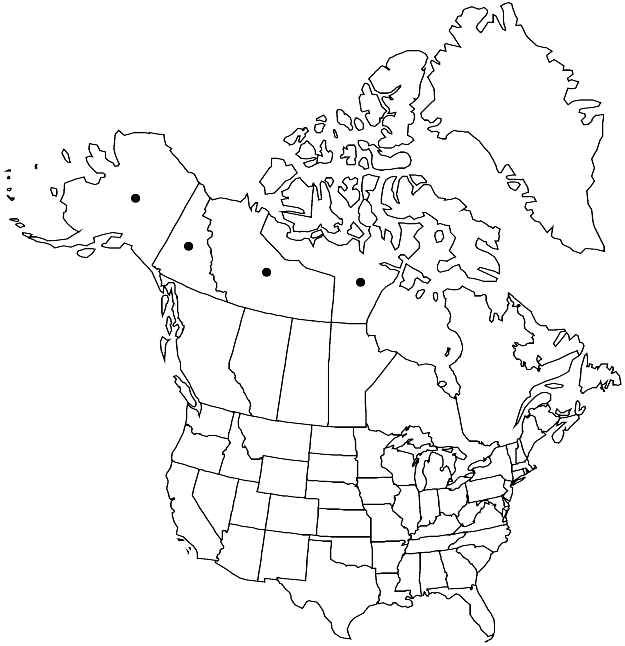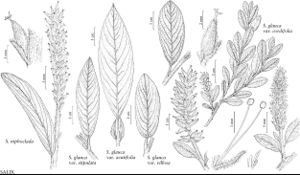Difference between revisions of "Salix glauca var. stipulata"
in C. A. M. Lindman, Sv. Fanerogamfl. ed. 2, 205. 1926.
FNA>Volume Importer |
imported>Volume Importer |
||
| (5 intermediate revisions by 2 users not shown) | |||
| Line 1: | Line 1: | ||
{{Treatment/ID | {{Treatment/ID | ||
|accepted_name=Salix glauca var. stipulata | |accepted_name=Salix glauca var. stipulata | ||
| − | |accepted_authority=Floderus | + | |accepted_authority=Floderus |
|publications={{Treatment/Publication | |publications={{Treatment/Publication | ||
|title=in C. A. M. Lindman, Sv. Fanerogamfl. ed. | |title=in C. A. M. Lindman, Sv. Fanerogamfl. ed. | ||
| Line 11: | Line 11: | ||
|name=Salix stipulifera | |name=Salix stipulifera | ||
|authority=Floderus ex Hayren | |authority=Floderus ex Hayren | ||
| + | |rank=species | ||
}} | }} | ||
|hierarchy=Salicaceae;Salix;Salix subg. Chamaetia;Salix sect. Glaucae;Salix glauca;Salix glauca var. stipulata | |hierarchy=Salicaceae;Salix;Salix subg. Chamaetia;Salix sect. Glaucae;Salix glauca;Salix glauca var. stipulata | ||
| Line 36: | Line 37: | ||
-->{{#Taxon: | -->{{#Taxon: | ||
name=Salix glauca var. stipulata | name=Salix glauca var. stipulata | ||
| − | + | |authority=Floderus | |
| − | |authority=Floderus | ||
|rank=variety | |rank=variety | ||
|parent rank=species | |parent rank=species | ||
| Line 51: | Line 51: | ||
|publication year=1926 | |publication year=1926 | ||
|special status= | |special status= | ||
| − | |source xml=https:// | + | |source xml=https://bitbucket.org/aafc-mbb/fna-data-curation/src/2e0870ddd59836b60bcf96646a41e87ea5a5943a/coarse_grained_fna_xml/V7/V7_98.xml |
|genus=Salix | |genus=Salix | ||
|subgenus=Salix subg. Chamaetia | |subgenus=Salix subg. Chamaetia | ||
Latest revision as of 22:37, 5 November 2020
Plants 0.3–1 m. Stems: branches gray-brown to red-brown, densely villous; branchlet color obscured by hairs, densely villous. Leaves: stipules sometimes marcescent, foliaceous (sometimes obscured by hairs) on early ones, foliaceous and prominent on late ones, linear to narrowly elliptic, 2–17 mm, apex acute to caudate; petiole 1–9 mm, villous adaxially; largest medial blade (hemiamphistomatous), sometimes narrowly oblong, 27–74 × 8–24 mm, 2.1–3.9 times as long as wide, base rounded, apex acuminate, convex, or acute, abaxial surface densely villous or villous-silky, hairs straight or wavy, adaxial moderately densely villous, or long-silky to glabrescent; proximal blade margins entire; juvenile blade densely villous or long-silky. Catkins: staminate 14–26 × 8–14 mm, flowering branchlet 1–14 mm; pistillate stout or subglobose, 15–54 × 7–15 mm, flowering branchlet 2–19 mm; floral bract tawny, light brown or bicolor, 1.2–2.2 mm, apex convex, hairs straight, wavy, or crinkled. Staminate flowers: abaxial nectary 0.3–1 mm; filaments distinct or partly connate, glabrous, or hairy on proximal 1/2. Pistillate flowers: adaxial nectary sometimes flask-shaped, (0.4–)0.6–1.8 mm; stipe 0.4–1.8 mm; ovary obclavate or pyriform, very densely villous or tomentose, beak abruptly tapering to styles; ovules 10–20 per ovary; styles connate to distinct, 0.4–1 mm; stigmas slenderly cylindrical, 0.3–0.8 mm. Capsules 4.5–7.5 mm. 2n = 76, 114, 152.
Phenology: Flowering mid Jun-mid Jul.
Habitat: Black spruce treed bogs, white spruce woods, floodplains, subarctic thickets, alpine tundra
Elevation: 0-1000 m
Distribution

N.W.T., Nunavut, Yukon, Alaska, Eurasia (China, n Mongolia, Russia, Scandinavia).
Discussion
Hybrids:
Variety stipulata forms natural hybrids with Salix arctica, S. arctophila, and probably others.
Selected References
None.
